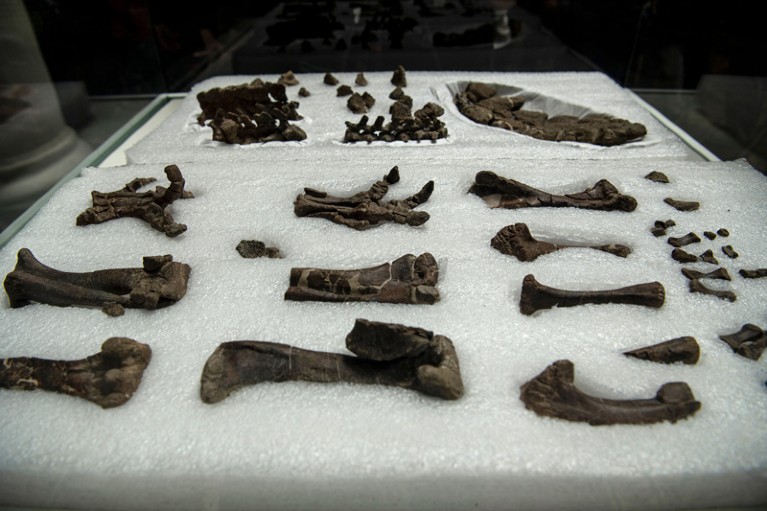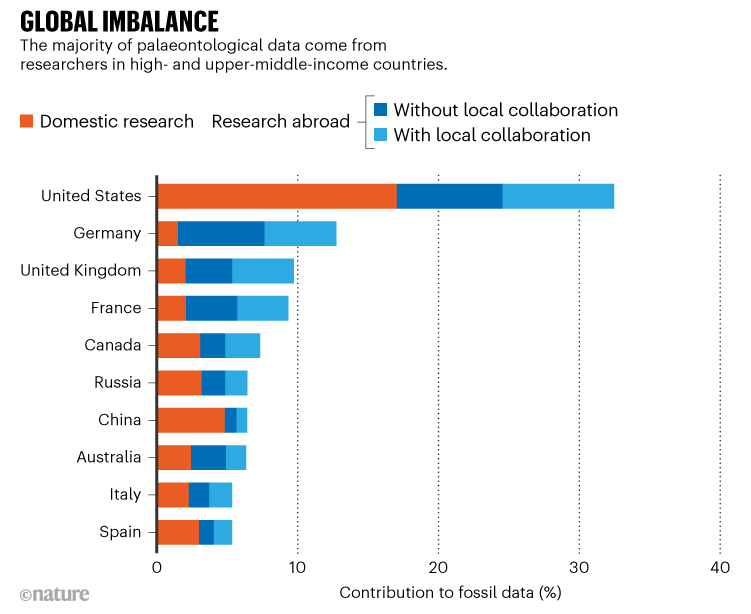Hello Nature readers, would you like to get this Briefing in your inbox free every day? Sign up here.

The fossilized bones of the dinosaur Stegouros elengassen were excavated in Chilean region of Patagonia, South America.Credit: Martin Bernetti/AFP/Getty
An imbalance in the fossil record
Our understanding of the history of life on Earth is biased towards wealthier countries, warns a study of the fossil record. The analysis reveals that 97% of palaeontological data come from scientists in high- and upper-middle-income countries, such as the United States, Germany and China. “I knew it was going to be high, but I didn’t think it was going to be this high. It was astonishing,” says palaeontologist Nussaïbah Raja. The analysis also found that colonial ties shed decades ago are still affecting palaeontology. For example, one-quarter of palaeontological research in Morocco, Tunisia and Algeria — former French colonies — was done by scientists based in France.
Reference: Nature Ecology & Evolution paper

Source: Ref. 1
Omicron thwarts inactivated-virus vaccines
Laboratory evidence suggests that the world’s most widely used COVID-19 vaccines — those containing inactivated SARS-CoV-2 — provide little to no protection against infection with the Omicron variant. But inactivated vaccines might still protect against severe disease and so remain crucial for preventing hospitalization and death from COVID-19. Inactivated vaccines include those made by China’s Sinovac and Sinopharm, which together account for nearly 5 billion of the COVID-19 vaccine doses delivered globally so far. More than 200 million doses of other inactivated shots, such as India’s Covaxin, Iran’s COVIran Barekat and Kazakhstan’s QazVac, have been administered.
Africa’s giraffe populations are rebounding
Giraffe numbers across Africa have grown to 117,000 — more than 20% higher than the population in 2015. Across 21 surveyed countries, 3 of 4 known species have significantly increased in numbers. “While advanced survey methods may be the reason for some of the increase in population estimates, there has been very positive indicators that conservation programs on the ground are also having a profound impact,” says biologist Jenna Stacy-Dawes.
National Geographic | 8 min read
Reference: Reference Module in Earth Systems and Environmental Sciences paper
Features & opinion
You can go back to academia
After leaving academia when her children were babies, neuroscientist Rachel James is back as a postdoctoral research fellow. Her post is a part-time fellowship from a UK charity that supports people returning to research careers after a break. “Many scientists think of moving out of academia as a permanent career move,” writes James. “For me, leaving research was a difficult decision, but I’ve learnt that it’s entirely possible to return, given the right approach.”
Futures: The lucky ones
A thread of hope stretches through a dystopian future of long queues in the latest short story for Nature’s Futures series.
Podcast: Hear the lost sounds of spring
As our environments change, so too do the sounds they make — and this can affect us in a host of ways, from our well-being to how we think about conservation. Ecologist Simon Butler is combining community-science data with technology to recreate soundscapes lost to the past. Butler hopes to better understand how soundscapes change in response to changes in the environment, and to use this to predict the soundscapes of the future.
I also spoke to the Nature Podcast this week about the science news from the holiday period that you might want to catch up on, including the verdicts in the trials of chemist Charles Lieber and Theranos founder Elizabeth Holmes, and a goldfish that can drive a tank.
Nature Podcast 1 | 13 min listen & Nature Podcast 2 | 20 min listen
Subscribe to the Nature Podcast on Apple Podcasts, Google Podcasts or Spotify.
